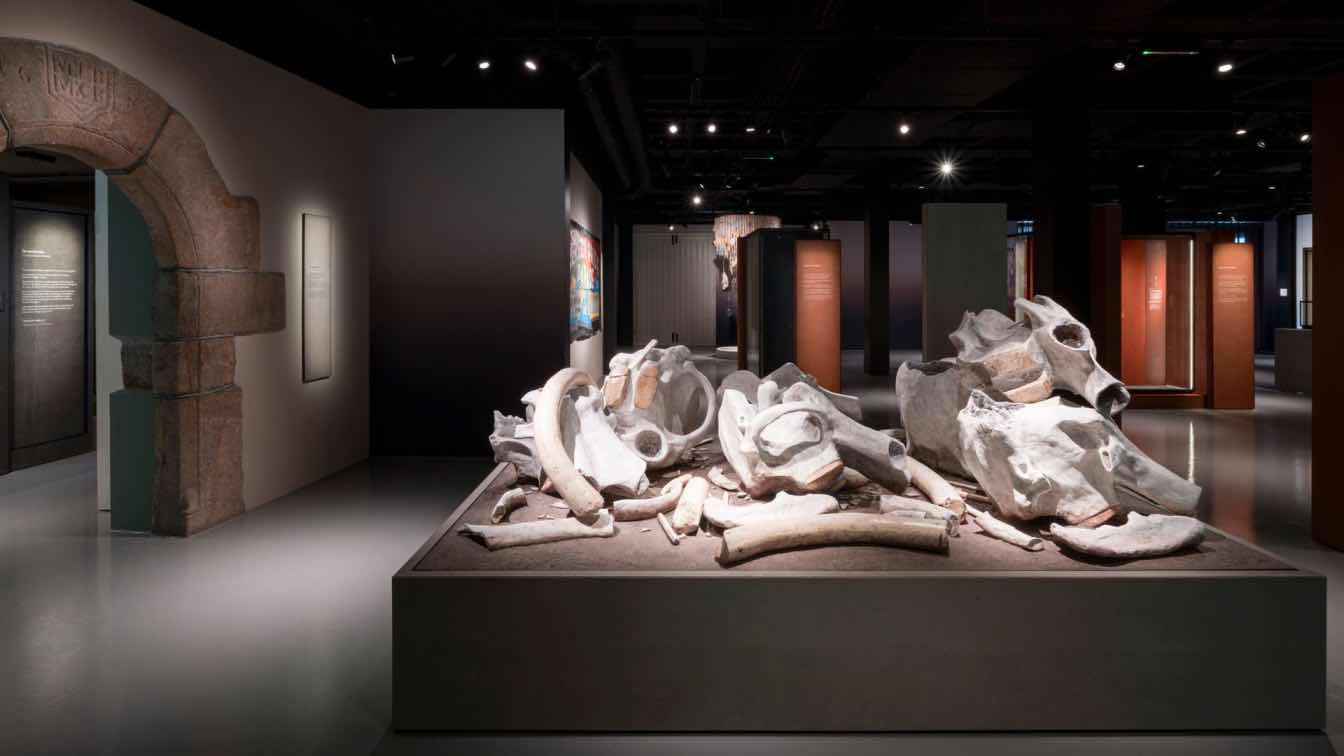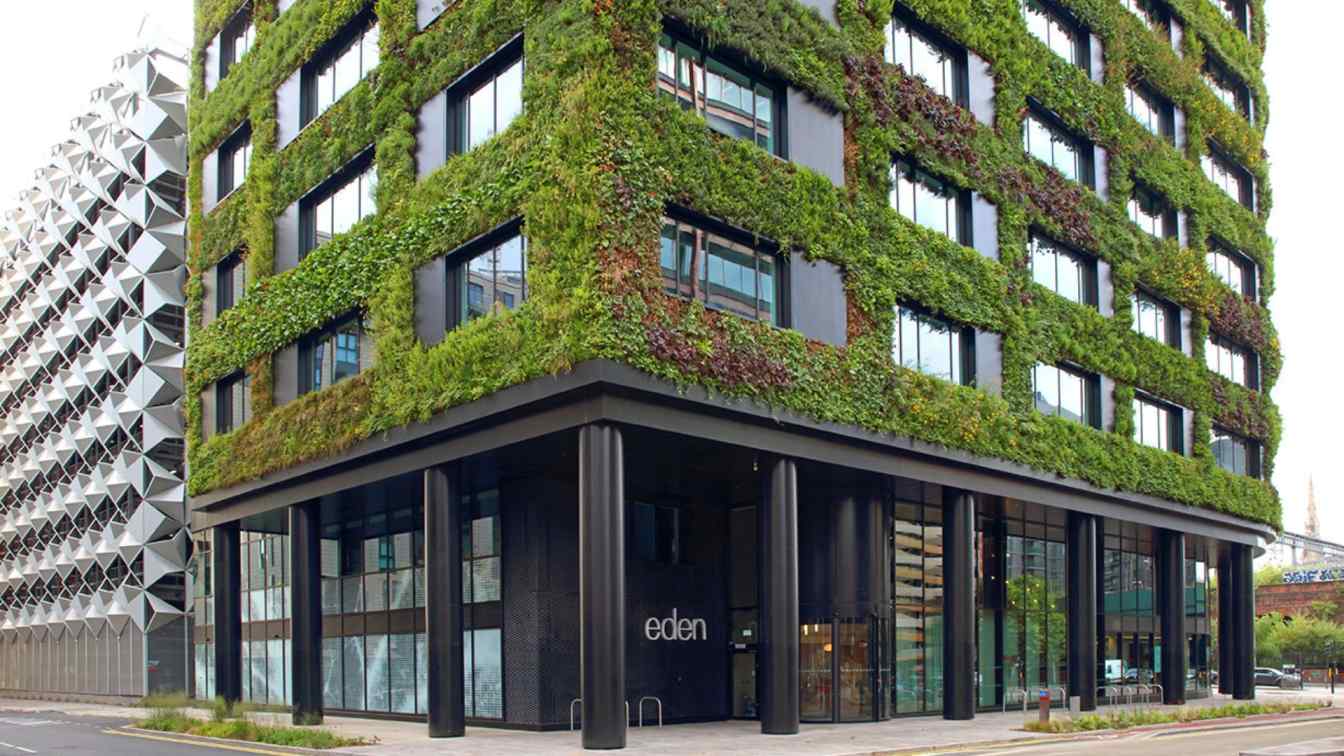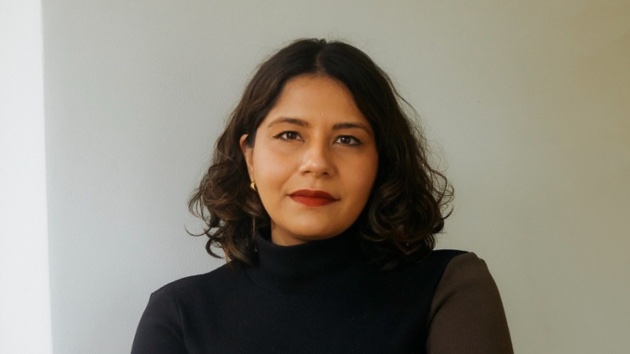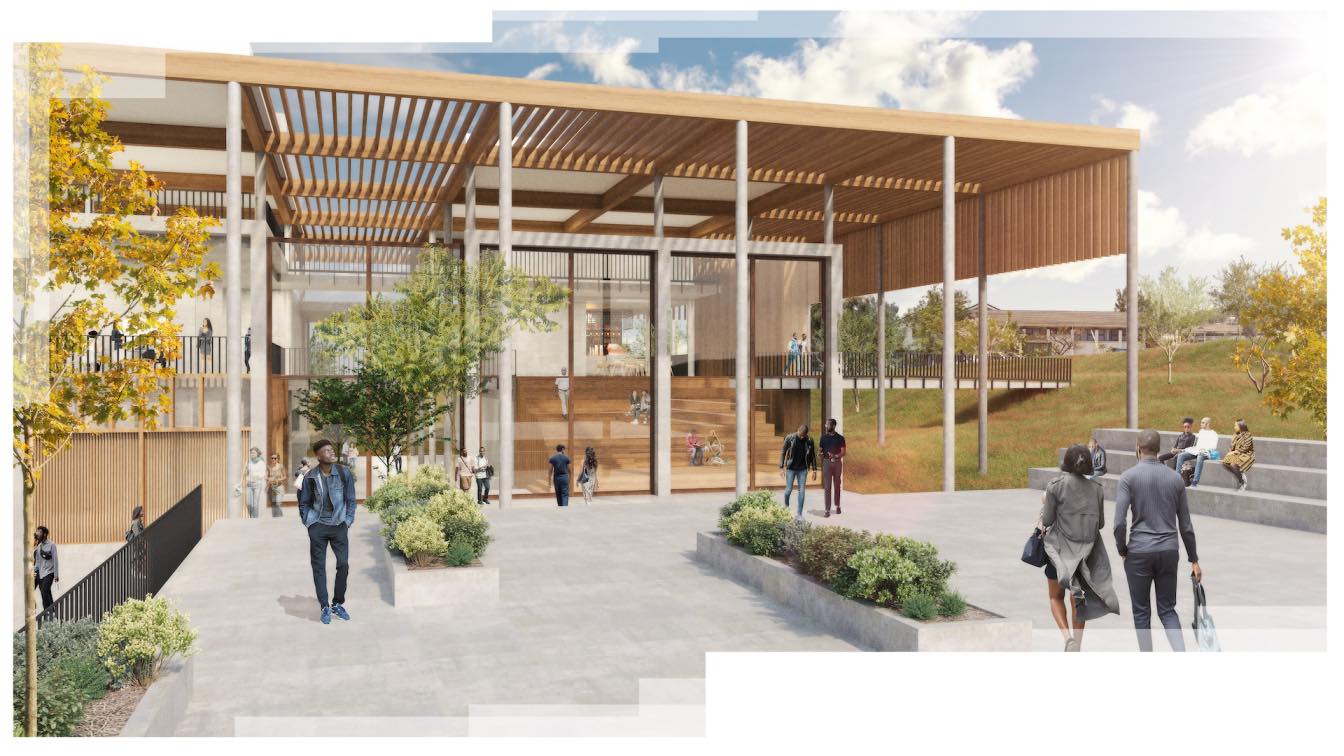Nissen Richards Studio has designed a new permanent exhibition for The Jersey Museum and Art Gallery. The exhibition has a thematic structure, featuring a group of stories arranged as ‘narrative islands’. The exhibition - ‘La Tèrr’rie d’Jèrri – d’s histouaithes dé not’ Île / Being Jersey – Stories of our Island’ – considers the island of Jersey through perspectives that are both literal and metaphorical, relating to the island as ‘sacred’, ‘exotic’ or ‘contested’, for example. Although individual, these narrative islands then come together to tell the story of the uniqueness of Jersey.
The 485 sq m exhibition is a major move for the Museum – and for its client, Jersey Heritage - and involved the complete transformation of the previous permanent exhibition, with the clear directive to undertake a totally new approach. The exhibition title is given in English and Jèrriais, the traditional language of the Jersey people. The use of this historic, Norman Romance language is in decline, but the Museum is one of the institutions actively seeking to preserve the language through its role as keeper and protector of the island’s heritage.
The Jersey Museum Building
The Jersey Museum is located in Jersey’s capital city, St Helier, in the old part of town, overlooking the harbour and seascape and set amongst a number of other historic buildings – including neighbouring attractions the Maritime Museum, the Waterfront Gardens and Elizabeth Castle. One part of the original building was built in 1795 by Matthew Gosset as a store called La Longue Caserne, whilst the other is a restored Victorian house. An extension, which created a new link building between the two, was added in 1990.
The current building is made up of three storeys, with the ground floor dedicated to visitor arrival, along with a café and shop. The new permanent exhibition takes up the whole of the first floor, whilst a second floor, not part of this redesign, is dedicated to temporary exhibitions.

Scope of the Exhibition
Although Jersey is just a tiny island – a small dot on the world map, its size belies the breadth of its unique and varied heritage. The exhibition celebrates some of the Island’s most significant moments and discovers how living here has affected the lives of its inhabitants. Using special objects as witnesses to the past, the exhibition explores what Jersey means both as an Island and to its Islander people.
Design Approach
Nissen Richards Studio won the commission to redesign the permanent exhibition in summer 2023. The brief stated that the existing exhibition had become outdated and that a new iteration needed to be more flexible, whilst remaining extensive in scope, covering the island’s history from the Ice Age to the present day. The objects in the permanent collection also needed to be celebrated more, with the narrative more to the forefront.
‘Our design approach took inspiration from Jersey’s unique landscape’, Pippa Nissen, Director of Nissen Richards Studio, commented. ‘The beach and seascape are so dominant wherever you are in Jersey and the physical nature of the island so strong. Colours and textures are very particular, from the sunset to the beach and water. We explored this, researching new materials we’d never used before and prototyping them to ensure they evoked a real feeling of the island.’
This research and exploration process led to the creation of a specific ‘Jersey palette’ for the scheme, with more tonal, earthy colours in the main space and, later, a more intense palette used to represent a shift in mood as the subject matter darkens too. In terms of materiality, the palette was made up of design ideas directly informed by the marks, traces, grooves and layers of the island’s archaeology, whilst also considering the expanse of the island and ideas relating to drama, light and colour taken from the sea, sky and horizon lines. The concept of tide and time influenced ideas about layering and the leaving behind of transient and permanent marks. Textures relating to the landscape included specific pigments and textures that could be rough, raw and earthen. The land’s stories suggested the development of a design language that sought to hold, imprint, etch and carve information.
Nissen Richards Studio also undertook the exhibition’s graphic design, creating the information hierarchy and panels and labels according to the chosen colour for each section of the exhibition, giving information ranging from introduction and theme to sub-sections, highlight exhibits and secondary messages and detail.

Exhibition Layout
When it came to the exhibition content, the big question was whether to organise thematically or chronologically - and how to structure the pacing. The final answer is a mixture of both, examining the nature and history of the island through six thematic viewpoints. The exhibition is broken down into six ‘island’ spaces, with a central object case in each allowing for stories to unfold around it in a cluster.
Although the narrative islands are individual story groups that can be enjoyed on their own and in any order, they are of course located next to other story groups, which made the order and interrelation important, in order to feel natural to the visitors choosing to access the ‘islands’ sequentially.
Exhibition Walk-through
Însulaithe / L’aithe à l’înseu
(Is)land
The historic timeline in this first section covers the Ice Age and pre-historic eras. The actual land of the island was once part of France before it became separated and still has unique flora and fauna because of that. Key objects here include the La Cotte bone heap replica – a set of reproduction bones created to mimic the archaeological site of La Cotte de St Brelade, where bone heaps (mammoth and rhinoceros) were carefully and deliberately built up over a long period.
Île du scîn
Sacred Island
Set in the bronze age, this section explores the discoveries that demonstrate early occupation of Jersey through time, with religious artefacts that may be related to burial rituals alongside coin hoards and jewels once buried and hidden to keep them safe from attackers. A jadeiete axe and gold torque are key objects and hold the central vista as visitors enter the exhibition.
Eune Île à part
An Island apart
In this section, the beginning of the island as a separate entity is explored through works on paper relating to laws that differ from those on the mainland, along with charters and historical records. Jersey is not a part of the United Kingdom, but is rather a British Crown Dependency, defended and internationally represented by the UK government.
Different demographic groups over time are examined here, with women’s history, for example, a focus point including both historic witch trials and, closer to the modern era, women’s suffrage.

Pause for Reflection
A midway reflection space offers visitors a quiet threshold zone and a visible break from the main exhibition floor. The pause space is separated by a dark, translucent curtain and offers views out to the harbour. There are no objects displayed here, only interpretation, including sound-only content about the local language, Jèrriais. The sound is integrated into the custom-designed benches in this section, where individual pick-up narrations are given by voice actors, demonstrating the Jersey accent and Jèrriais.
Entchéthinné d’l’Île
Exotic Island
This section looks at Jersey as a destination, partly for tourism and honeymooners, but also for the actors and artists who have made it their home. The theme is exemplified by the inclusion of two portraits of the actress Lillie Langtry, both painted by male artists and both exhibited at the Royal Academy in London in 1878. The positioning of the portraits enables the viewer to draw direct comparisons between them. A separate room-set with a bespoke bench and projection shows a historical tourist film depicting Jersey in the 1960s.
Île contestée
Contested Island
This section sits in the main zone of the historical warehouse building, which is slightly smaller and more enclosed. A central artwork is the Thomas Whitcombe painting, ‘Jersey pier with a distant view of Elizabeth Castle.’
The focus here is on conflict and especially on the Nazi Occupation of the island during World War Two. Exhibits include the Occupation Registration Cards Islanders were forced to carry and and grids of faces from the Registration Cards in a large-scale graphic, communicating the vast number of different people caught up in the conflict.

Île abriée
Island Haven
This area has a more gallery feel and centres on artists and photographers who have made the island their home. The space is separated out by hatches and doorways, with new plaster cladding around each, set into the original stone warehouse wall, with through-views offering spotlights on the photos and slides on display.
The design team sought to make the retained architectural features feel cohesive within the exhibition environment and as objects in themselves. This was achieved through a high-level lighting detail that creates a wash of light across the wall, drawing attention to its texture and markings. The door surrounds and concrete additions to the historic wall were also painted to ensure they felt integrated into the space.
Three artists in particular are in focus in this section: Victor Hugo, Thomas Sutton and Claude Cahun. The latter is the assumed or artistic name of Lucie Schwob, who moved to the island with her partner Suzanne Malherbe, having first been part of the surrealist art community in Paris. Working on photography together under the names Claude Cahun and Marcel Moore, the couple’s images resound with themes of gender and identity that make them particularly resonant for today’s audiences. Their presence here, however, relates not only to their art but to the Nazi Occupation, where both took an active resistance role, before being arrested and sentenced to death, escaping that terrible destiny thanks to the island’s liberation in May 1945.
Another key object, in addition to the artworks, is a Pierre Amiraux coffee pot, made by a descendant of Huguenot silversmiths, who fled France in 1685 when their Protestant religion was banned by King Louis XIV. Many skilled Huguenot professionals made their home in Jersey during the exodus, including the Amiraux family, who set up a business making and selling high-quality silver goods in St Helier.

Louise Downie, Curation and Experience Director at Jersey Heritage, commented: ‘Nissen Richards Studio have created an exhibition which is, like our island, beautiful, breathtaking, emotive and atmospheric. They understood our overall exhibition concept of ‘Islandness’ in developing a palette of colours, textures and materials that reflect the physical environment of the Island and translated curatorial interpretive framework and intent into a design scheme which conveys the key messages and themes in a strong visual identity.
‘The exhibition includes a variety of object types – archaeology, social history, paper archives and art – a conservation challenge which Nissen Richards Studio took on with knowledge, professionalism and meticulous attention to detail. Nissen Richards Studio also comprehended Jersey Heritage’s need to future-proof the exhibition, creating a flexible design with room to grow.’
Photography: Gareth Gardner
Lighting Designer: Studio ZNA
Setworks Contractor: MER
Showcases: Floria D.sign
AV Software: Elbow
AV Hardware: D J Willrich
Basebuild Contractors: V&V Builders & Stonemasons
M&E: Ennis










































About Nissen Richards Studio:
Nissen Richards Studio is a triple RIBA National Award-winning architects’ practice and exhibition design studio, working with many of the world’s greatest cultural institutions, from The Courtauld Gallery, The National Portrait Gallery, The British Museum, British Library, National History Museum, National Trust, The Wallace Collection, Wordsworth Trust, HRP and The Imperial War Museum in the UK to Kode, MUNCH and the National Library of Norway internationally.
Founded in 2010 and led by Directors Pippa Nissen and Jim Richards, Nissen Richards Studio’s approach combines a respect for all the voices in a project, a willingness to experiment, a unique storyboarding process and a fusion of architectural and theatre design processes. Nissen Richards Studio’s clear systems of thinking, working and communicating, together with a boundless curiosity about the world, translate into beautifully designed spaces for people to come to, be stimulated by, enjoy and remember.





